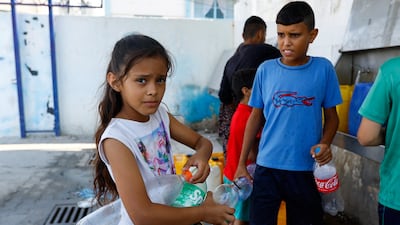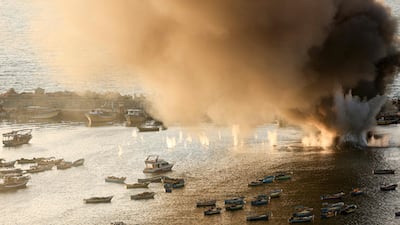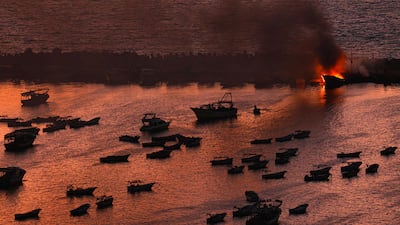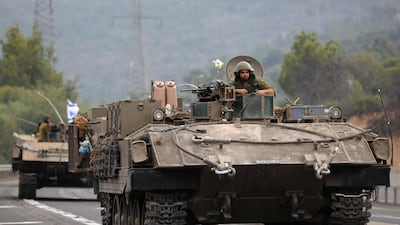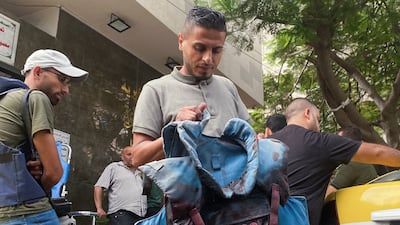Live updates: Follow the latest news on Israel-Gaza
From the chariot to the longbow, gunpowder, the tank, aeroplane and nuclear bombs, military leaders have long sought invincible weapons.
A new arm has entered service, giving dangerous confidence to weaker forces, and used effectively by Hamas in its attack on Israel.
As Israel shuts down a key offshore gasfield, a proliferation of drones and guided cruise missiles threatens not just soldiers, but critical infrastructure providing energy supplies for modern life.
The rise of relatively humble, cheap but numerous Turkish-built drones was prominent in Azerbaijan’s speedy defeat of Armenia in September-November 2020.
Watch: Israel pounds Gaza after evacuation deadline expires
But from an energy viewpoint, such weapons proved their capability earlier.
Experience from clashes such as the Iran-Iraq war, when both sides pounded away at oilfields, refineries and terminals, suggested that relatively small energy targets were hard to damage with inaccurate unguided missiles, or by planes that were vulnerable to interception.
But in September 2019, drones and cruise missiles, claimed by Houthi forces in Yemen, but more likely coming from Iran or Iran-linked groups in Iraq, hit the Abqaiq oil-processing facility and Khurais oilfield in Saudi Arabia, evading radar and the Patriot missile defence system.
The strikes temporarily knocked out 5.7 million barrels per day of oil production.
They appeared to be carefully calibrated to avoid major permanent damage, and Saudi Arabia was able to restore full capacity within a few weeks.
The main effect was political, demonstrating Iran’s ability to cause severe disruption to energy facilities key not only for Saudi Arabia, but for global oil consumers.
Drones have again been prominent in the Russia-Ukraine war, and not just on the front lines.
Russia has repeatedly struck at Ukrainian electricity supplies, especially last winter, aiming to disrupt the economy and break morale.
Ukraine has hit back through a series of shadowy attacks and somewhat unexplained explosions at Russian refineries, fuel depots and power plants.
These drones are not just aerial. Ukraine has innovated with marine drones, used in a series of attacks on Russia’s Black Sea fleet, the Kerch Bridge to Crimea and, in August, oil tankers.
That leads to perhaps the most mysterious recent energy sabotage.
Last September, three of the four lines of the Nord Stream I and II gas pipelines running from Russia to Germany under the Baltic Sea were destroyed by explosions.
Every plausible and implausible candidate has been blamed, including Russia, Ukraine or pro-Ukrainian groups, Nato, the US and the UK, but no proof has emerged.
On Tuesday, another Baltic gas pipeline between Finland and Estonia was broken by an apparent explosion, which Finland blames on “outside activity”.
Neither this nor the Nord Stream sabotage had to be carried out by drone – explosives laid by divers, mini-submarines or remotely operated vehicles from ships are most likely.
But it does show the vulnerability of the increasingly dense network of subsea pipelines, electricity and fibre-optic cables, growing as grids are integrated and offshore wind farms advance.
Following Hamas’s surprise attack, Israel shut down the important Tamar gasfield, whose production platform can be seen from Gaza on a clear day.
Israel-Gaza war latest - in pictures
This was apparently precautionary. The facilities for Israel’s two other producing fields, Leviathan and Karish, are located much further north, near the Lebanese offshore border.
Tamar was also briefly closed during the unrest of May 2021, albeit that was much less serious.
The Israel Defence Forces claimed to have thwarted a submarine drone attack from Gaza on Tamar, and that rockets had also been unsuccessfully fired at the platform.
In July 2022, the IDF said it had downed three reconnaissance drones launched by Hezbollah towards the Karish floating production vessel.
On Saturday, unofficial reports suggested the much-watched Qana well, being drilled by France’s TotalEnergies in Lebanon just over the boundary line, had failed to find gas.
That remains to be confirmed but, if true, it would dampen the incentive for Hezbollah to avoid targeting Israeli energy infrastructure for fear of retaliation.
Tamar provides nearly half of Israel’s gas production, and contributes to its exports to Jordan and Egypt.
In turn, Egypt had been in the process of resuming liquefied natural gas exports, helping to supply Europe.
For now, there is no reason to expect the closure to be prolonged, but if it were, it would tighten global gas supplies as the Northern Hemisphere winter approaches.
European gas prices have risen by more than half since last Saturday, mostly because of the ominous Baltic pipeline rupture.
Drones have several advantages. They can be cheap and simple, well within the capability of weaker or poorer states as well as non-state groups.
Therefore they can be deniable, making it hard for the target to know who to retaliate against and how.
There are no easy answers to this new threat: the energy industry and defence forces need to learn quickly and be prepared for the unexpected and even the previously unthinkable
Robin Mills
They can overwhelm expensive conventional defences with a combination of numbers and undetectability. And they avoid exposing their users directly to harm.
Their main weakness is dependence on GPS systems and communications from human operators, which can be blocked by electronic measures.
That may disappear as fully autonomous drones, micro-drones and swarms are deployed. Drone attacks are also more effective when teamed with guided missiles and bombs, cyberwarfare, and traditional ground forces and misdirection.
New weapons win battles and even campaigns, but rarely provide a durable strategic advantage.
Opponents adopt them, or find ways to counter them. Nevertheless, they can lead countries or armed groups to start conflicts against apparently much stronger opponents. They also change the nature and targets of warfare.
Both the Middle East and Europe abound in exposed energy infrastructure. Defences can be beefed up, and critical systems can be hardened.
Ukraine’s experience in keeping much of its heat, water and electricity flowing even through prolonged attacks is testament to the value of robustness, duplication and improvisation.
Still, there are no easy answers to this new threat: the energy industry and defence forces need to learn quickly and be prepared for the unexpected, and even the previously unthinkable.
Robin M. Mills is chief executive of Qamar Energy, and author of The Myth of the Oil Crisis
The%20Roundup%20%3A%20No%20Way%20Out
%3Cp%3E%3Cstrong%3EDirector%3A%3C%2Fstrong%3E%20Lee%20Sang-yong%3Cbr%3E%3Cstrong%3EStars%3A%3C%2Fstrong%3E%20Don%20Lee%2C%20Lee%20Jun-hyuk%2C%20Munetaka%20Aoki%3Cbr%3E%3Cstrong%3ERating%3A%20%3C%2Fstrong%3E3%2F5%3Cbr%3E%3Cbr%3E%3C%2Fp%3E%0A
Yahya Al Ghassani's bio
Date of birth: April 18, 1998
Playing position: Winger
Clubs: 2015-2017 – Al Ahli Dubai; March-June 2018 – Paris FC; August – Al Wahda
Habib El Qalb
Assi Al Hallani
(Rotana)
Ferrari
%3Cp%3E%3Cstrong%3EDirector%3A%3C%2Fstrong%3E%20Michael%20Mann%26nbsp%3B%3C%2Fp%3E%0A%3Cp%3E%3Cstrong%3EStarring%3A%3C%2Fstrong%3E%20Adam%20Driver%2C%20Penelope%20Cruz%2C%20Shailene%20Woodley%2C%20Patrick%20Dempsey%3C%2Fp%3E%0A%3Cp%3E%3Cstrong%3ERating%3A%3C%2Fstrong%3E%203%2F5%3C%2Fp%3E%0A
UAE currency: the story behind the money in your pockets
EGYPT SQUAD
Goalkeepers: Ahmed El Shennawy, Mohamed El Shennawy, Mohamed Abou-Gabal, Mahmoud Abdel Rehem "Genesh"
Defenders: Ahmed Elmohamady, Ahmed Hegazi, Omar Gaber, Ali Gazal, Ayman Ahsraf, Mahmoud Hamdy, Baher Elmohamady, Ahmed Ayman Mansour, Mahmoud Alaa, Ahmed Abou-Elfotouh
Midfielders: Walid Soliman, Abdallah El Said, Mohamed Elneny, Tarek Hamed, Mahmoud “Trezeguet” Hassan, Amr Warda, Nabil Emad
Forwards: Ahmed Ali, Mohamed Salah, Marwan Mohsen, Ahmed "Kouka" Hassan.
EA Sports FC 26
Publisher: EA Sports
Consoles: PC, PlayStation 4/5, Xbox Series X/S
Rating: 3/5
Ain Dubai in numbers
126: The length in metres of the legs supporting the structure
1 football pitch: The length of each permanent spoke is longer than a professional soccer pitch
16 A380 Airbuses: The equivalent weight of the wheel rim.
9,000 tonnes: The amount of steel used to construct the project.
5 tonnes: The weight of each permanent spoke that is holding the wheel rim in place
192: The amount of cable wires used to create the wheel. They measure a distance of 2,4000km in total, the equivalent of the distance between Dubai and Cairo.
Company profile
Date started: 2015
Founder: John Tsioris and Ioanna Angelidaki
Based: Dubai
Sector: Online grocery delivery
Staff: 200
Funding: Undisclosed, but investors include the Jabbar Internet Group and Venture Friends
Mohammed bin Zayed Majlis
COMPANY%20PROFILE
%3Cp%3E%3Cstrong%3EName%3A%3C%2Fstrong%3E%20Carzaty%2C%20now%20Kavak%3Cbr%3E%3Cstrong%3EBased%3A%3C%2Fstrong%3E%20Dubai%3Cbr%3E%3Cstrong%3ELaunch%20year%3A%20%3C%2Fstrong%3ECarzaty%20launched%20in%202018%2C%20Kavak%20in%20the%20GCC%20launched%20in%202022%3Cbr%3E%3Cstrong%3ENumber%20of%20employees%3A%3C%2Fstrong%3E%20140%3Cbr%3E%3Cstrong%3ESector%3A%3C%2Fstrong%3E%20Automotive%3Cbr%3E%3Cstrong%3EFunding%3A%20%3C%2Fstrong%3ECarzaty%20raised%20%246m%20in%20equity%20and%20%244m%20in%20debt%3B%20Kavak%20plans%20%24130m%20investment%20in%20the%20GCC%3C%2Fp%3E%0A
The specs
Engine: 2.0-litre 4cyl turbo
Power: 261hp at 5,500rpm
Torque: 405Nm at 1,750-3,500rpm
Transmission: 9-speed auto
Fuel consumption: 6.9L/100km
On sale: Now
Price: From Dh117,059
Our family matters legal consultant
Name: Hassan Mohsen Elhais
Position: legal consultant with Al Rowaad Advocates and Legal Consultants.
Tori Amos
Native Invader
Decca
Palestine and Israel - live updates
The%20specs
%3Cp%3E%3Cstrong%3EEngine%3A%20%3C%2Fstrong%3E4.0-litre%20flat%206-cylinder%0D%3Cbr%3E%3Cstrong%3ETransmission%3A%20%3C%2Fstrong%3E7-speed%20PDK%0D%3Cbr%3E%3Cstrong%3EPower%3A%20%3C%2Fstrong%3E500hp%0D%3Cbr%3E%3Cstrong%3ETorque%3A%20%3C%2Fstrong%3E450Nm%0D%3Cbr%3E%3Cstrong%3EPrice%3A%20%3C%2Fstrong%3EDh530%2C300%20as%20tested%0D%3Cbr%3E%3Cstrong%3EOn%20sale%3A%3C%2Fstrong%3E%20Now%3C%2Fp%3E%0A
The biog
Name: James Mullan
Nationality: Irish
Family: Wife, Pom; and daughters Kate, 18, and Ciara, 13, who attend Jumeirah English Speaking School (JESS)
Favourite book or author: “That’s a really difficult question. I’m a big fan of Donna Tartt, The Secret History. I’d recommend that, go and have a read of that.”
Dream: “It would be to continue to have fun and to work with really interesting people, which I have been very fortunate to do for a lot of my life. I just enjoy working with very smart, fun people.”
Email sent to Uber team from chief executive Dara Khosrowshahi
From: Dara
To: Team@
Date: March 25, 2019 at 11:45pm PT
Subj: Accelerating in the Middle East
Five years ago, Uber launched in the Middle East. It was the start of an incredible journey, with millions of riders and drivers finding new ways to move and work in a dynamic region that’s become so important to Uber. Now Pakistan is one of our fastest-growing markets in the world, women are driving with Uber across Saudi Arabia, and we chose Cairo to launch our first Uber Bus product late last year.
Today we are taking the next step in this journey—well, it’s more like a leap, and a big one: in a few minutes, we’ll announce that we’ve agreed to acquire Careem. Importantly, we intend to operate Careem independently, under the leadership of co-founder and current CEO Mudassir Sheikha. I’ve gotten to know both co-founders, Mudassir and Magnus Olsson, and what they have built is truly extraordinary. They are first-class entrepreneurs who share our platform vision and, like us, have launched a wide range of products—from digital payments to food delivery—to serve consumers.
I expect many of you will ask how we arrived at this structure, meaning allowing Careem to maintain an independent brand and operate separately. After careful consideration, we decided that this framework has the advantage of letting us build new products and try new ideas across not one, but two, strong brands, with strong operators within each. Over time, by integrating parts of our networks, we can operate more efficiently, achieve even lower wait times, expand new products like high-capacity vehicles and payments, and quicken the already remarkable pace of innovation in the region.
This acquisition is subject to regulatory approval in various countries, which we don’t expect before Q1 2020. Until then, nothing changes. And since both companies will continue to largely operate separately after the acquisition, very little will change in either teams’ day-to-day operations post-close. Today’s news is a testament to the incredible business our team has worked so hard to build.
It’s a great day for the Middle East, for the region’s thriving tech sector, for Careem, and for Uber.
Uber on,
Dara
The 12 Syrian entities delisted by UK
Ministry of Interior
Ministry of Defence
General Intelligence Directorate
Air Force Intelligence Agency
Political Security Directorate
Syrian National Security Bureau
Military Intelligence Directorate
Army Supply Bureau
General Organisation of Radio and TV
Al Watan newspaper
Cham Press TV
Sama TV














